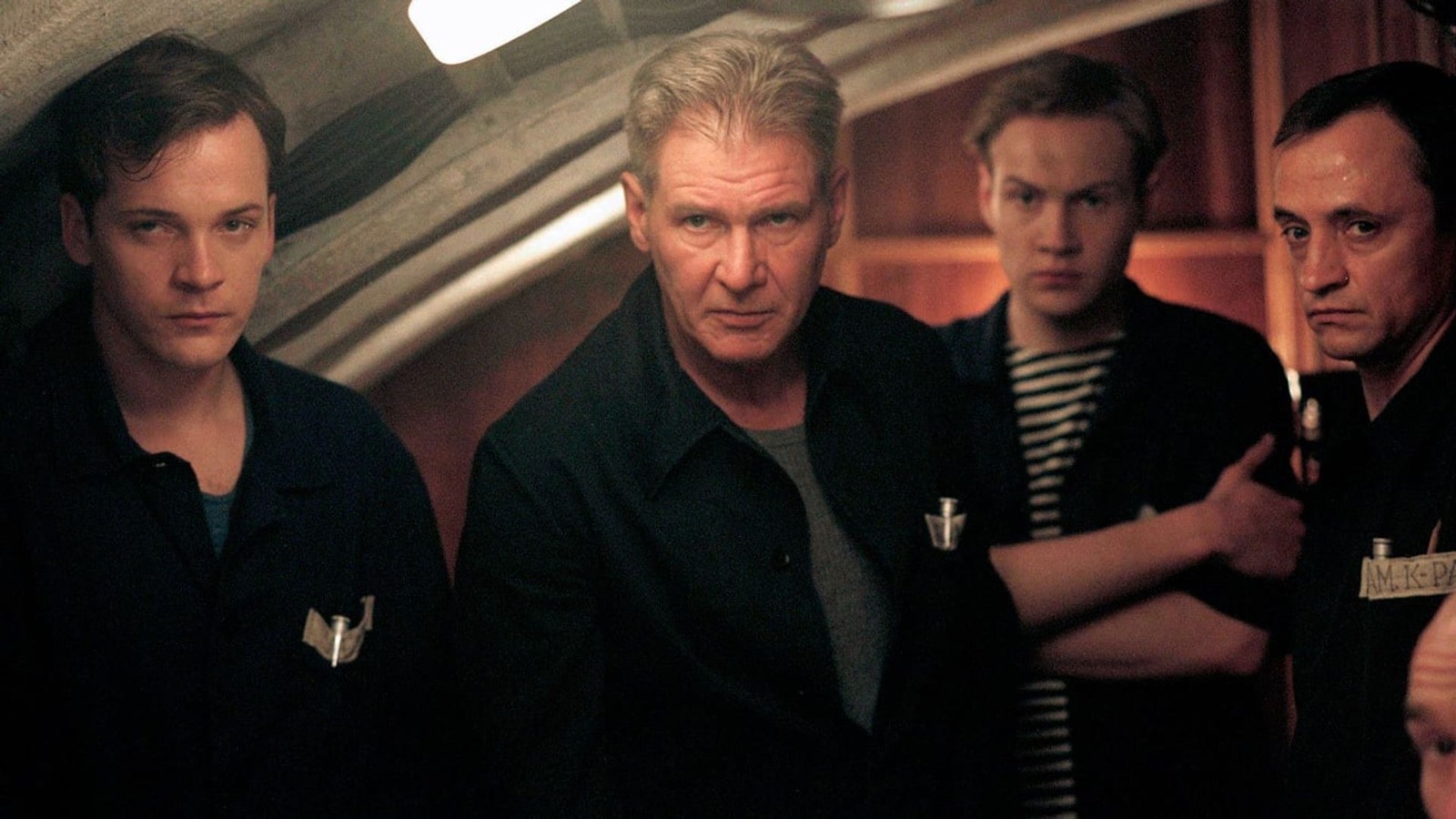“Under no circumstances will I abandon my boat or my crew to the enemy,” spouts an unflinching Harrison Ford. It’s the kind of line reading you’d expect in a Ford movie where he plays the undaunted American hero pitched against long odds. Except here, as Soviet captain Alexi Vostrikov, Ford trades in his fedora for a Russian brush cut, his rugged desirability for a stiff sexlessness, and his patriotic persona for a loathsome zealotry of the Soviet cause.
Kathryn Bigelow’s “K-19: The Widowmaker” had all of the makings of a sure-fire hit. Despite the stars, the against-all-odds story, and the artistic daring, it bombed toward obscurity. No one knew it at the time, but twenty years later, it’s clear: “K-19: The Widowmaker” is Ford’s most consequential movie, a misbegotten role that forever altered his career, and remains a rich text when viewed through the Russian invasion of Ukraine.
Set in 1961, “K-19” tells the story of a Soviet Union nuclear submarine, helmed by Vostrikov, that is first sent toward the Arctic to test the capabilities of launching a ballistic missile and then to America’s eastern seaboard. During their voyage, the Soviet crew discover the vessel’s nuclear reactor is leaking. If it continues every man onboard will die. And the ship will explode, thereby causing the destruction of the American destroyer tailing them, leading to World War III. The iron-willed Vostrikov must contend with Mikhail “Misha” Polenin (Liam Neeson), the popular executive officer he replaced as captain, his mutinous crew, and his own bootlicking sense of duty and patriotism to see his men as human rather than pawns of a totalitarian government.
“K-19” offers an instructional lesson on the strengths and limitations, and the responsibility placed upon a leading man. A movie’s quality and financial success can live or die based on his charisma, sex appeal, range, and general presence. It can take years of bouncing around from bit part to bit part and slowly honing one’s craft before an actor is entrusted with that mantle. Few leading men in the history of Hollywood have experienced a twenty-year run like Ford did, beginning with “The Empire Strikes Back” in 1980 to “What Lies Beneath” in 2000. By the time he arrived at “K-19” in 2002, his box office and pop culture hold as the premiere leading man showed few signs of loosening.

“I got plenty of advice to not take that character. He’s not a very nice guy,” recalls an impish Ford in the behind the scenes featurette: “Making of K-19.” By 1991, the Soviet Union had dissolved, thereby symbolically ending the Cold War. Although “K-19” went into production a decade later, the memories from the 44-year proxy conflict were still fresh among audiences. Still, Ford took the role of the taskmaster Soviet sub commander Vostrikov, and it says much about the actor’s bulletproof reputation as a leading man that a major studio, Paramount, not only put money behind this, but made the film a summer release. Fascinatingly, as Vostrikov, Ford turned his back on his best qualities: He sported a hammy but far from comical Russian accent, and barely brandished his beguiling smile or popped a witty joke. In fact, you spend much of the film despising this heartless character: a man driven solely by an unquestioned loyalty to the party.
While you could say audiences would have identified with Vostrikov if he were merely an American fighting for the US’ sovereignty and safety. His unlikablity goes beyond politics: In “Air Force One” and “Patriot Games,” films in which Ford plays characters espousing the same nationalistic fervor, except for the American neocolonialist cause, he was portrayed as a family man, which allowed him several tender scenes with children and spouses that are missing from the craggy and cold Vostrikov. Here he ignores the clear shortcomings to his boat—a sub rushed out to sea without basic equipment—and throws his men through grueling training exercises. Vostrikov is a detached bore on top of his mission to station a ship with nuclear capabilities outside of the United States as a deterrent.
“K-19” wasn’t the first time Ford bet his star persona against the backdrop of an unlikable character. In Peter Weir’s “The Mosquito Coast” (1986), as the selfish father Allie Fox, his privileged, white male toxicity endangers his family and exploits an Indigenous Central American community. As Rusty Sabich in Alan J. Pakula’s “Presumed Innocent” (1990). Ford portrayed a callous and philandering prosecutor accused of murdering his colleague and lover. Robert Zemeckis’ “What Lies Beneath” (2000) makes him a deranged Hitchcockian killer hellbent on offing his wife to cover up the murder of his former student. Nevertheless, his follow up to “What Lies Beneath,” “K-19,” was his biggest risk. In fact, it’s difficult to think of an A-list star playing two more unlikable characters back-to-back than Ford in “What Lies Beneath” and “K-19.” The closest might be Robin Williams in “One Hour Photo” and “Insomnia” (coincidently, both were released the same year as “K-19”). Still, unlike Williams, a comedian turned dramatic actor, in that regard occupying a far more liminal dramatic space, Ford personified the American hero to the point of playing the U.S. president fighting against Communist Soviet terrorists in “Air Force One.”
Earning only $65.7 million on a $90 million budget, the box office for “K-19” fell far short of the lofty standards set by Ford’s turns as Indiana Jones, Han Solo, and Jack Ryan. Nor did it match his romantic comedies (“Working Girl” and “Six Days, Seven Nights”). The film currently holds a 60% on Rotten Tomatoes with critic Stanley Kauffmann writing for the New Republic: “Why did movie moguls think that this was the right moment for a tale of unflinching loyalty to the Soviet Union?” Ford’s next eight out of ten films after “K-19” similarly bombed at the box office (the fourth Indiana Jones and “42” being the exceptions). And Bigelow was shunned for six years from directing until returning with her Best Picture winning film “The Hurt Locker.”

While Ford’s subversions often garnered his best performances, the rejection by audiences of his Soviet turn in “K-19” recalls James Baldwin’s observations regarding star personas in The Devil Finds Work: “No one, for example, will ever know whether Katharine Hepburn or Clark Gable—or John Wayne—can, or could, really act or not, nor does anyone care… One does not go to see them act: one goes to watch them be.” Because even in Ford’s most off-kilter choices, his characters’ endearing (and sometimes caustic) single-mindedness have bound them together. That independent streak is rendered mute when he plays Vostrikov, a man subservient to the totalitarian whims of empire building through mutually assured destruction (even in a militaristic movie like “Clear and Present Danger” Ford’s Jack Ryan defied orders).
And yet, “K-19” isn’t a bad movie. It swims in the wake of “Das Boot” and “Crimson Tide” as a sharp interrogation of the pressures inflicted upon hyper-masculine men confined to an unwinnable space by their hawkish government. At the right moments, DP Jeff Cronenweth (“The Social Network”) and Bigelow’s gliding camera transcend the tight areas of the sub: the opening training scene tracks the actors with tight close-ups as they wind through the narrow hallways of the sub from the engine room to the periscope. The rapid fire cutting by Walter Murch only adds to the freedom of movement.
In other instances, their lens barely captures all of the moving parts, the petty mechanitions for power in compositions favoring a claustrophobic physicality of men pushed together in control rooms. The missile launch scene, for instance, captures sailors so cramped against the steel walls of gears and buttons, they blend in against the ship’s robotics, thereby becoming mechanical in their stiffness too. Although Bigelow exercised zero quality control for each actor’s respective accents—some like Neeson speak in a low growl, Ford relies on a bundle of affectations mixed with his natural speech pattern, and some aren’t even trying—those choices do not deter the film’s dramatic heft.
Bigelow’s film works through two complementary moods, and first is impending doom. The Soviet brass do not trust Polenin, a good man more invested in the safety of his crew than his government, to get this ramshackle submarine to launch a nuclear warhead. Vostrikov, a man desperate to redeem his disgraced and deceased father, arrives aboard as the tough parent. Few on the crew like him: They want Polenin back, and a rash of ominous tragedies only deepens that desire. Tragedy pervades the second half of “K-19.” When the nuclear core on the submarine begins melting down, several men must enter the deadly radioactivity surrounding the core to pump in water and try to fix it, and Vostrikov is left to decide between the importance of the mission or his men.

Through doom and tragedy, Bigelow is most interested in humanizing these men. She shows Lieutenant Radtchenko (Peter Sarsgaard), the reactor officer, running through the snow to embrace his girlfriend before he departs on this dangerous mission. She tracks the jubilant sailors playing soccer on the Arctic ice and she presents their giddy faces as they pose for a group photo. She hones in on their scarred bodies ravaged by radiation poisoning, and makes the connection between the recklessness of their apathetic government and their physical sacrifice. Although “K-19” is about Soviet characters, the film itself doesn’t support the regime; that much is evident in Ford’s Vostrikov as he deprograms from a stoic tyrant willing to murder his men before he’d give up his ship to the American destroyer tailing them, to an empathetic leader willing to defy Moscow, even it means committing treason. Bigelow’s film maneuvers best when delving, through Vostrikov, into how public power, in this case over men and the fate of the world, leads to a festering private despair that can endanger everyone.
Setting his passable accent aside, Ford gives one of his more textured performances in a movie that surprisingly avoids his handsomeness: As crises mount, he physically transitions from standing upright to leaning in a hunch; his piercing glare communicates what his sparse dialogue doesn’t; and he nimbly pulls this character from wretchedness to admirability. Ford has rarely been better than in the scene where, after resigning himself to the reality of giving up his ship to the Americans, he suddenly learns from Polenin that the crew has been saved by the Soviets. The relief that washes across his face and frame could sink battleships.
Even so, “K-19” bombed. Critics were mixed on it. The accents were lampooned. No one wanted to see Ford, an American cinematic icon, playing a Soviet Russian. Even fewer were ready for a sympathetic, hero-worshiping appraisal of sailors from America’s longtime foe so soon after the Cold War. America’s pop culture spent considerable energy perpetuating Russia as the enemy in movies like “Red Dawn,” “Rocky IV,” and the aforementioned “Air Force One.” Heck, in the same year as “K-19,” “The Sum of All Fears,” the newest Jack Ryan, this one starring Ben Affleck, pitched a rogue Russia officer trying to instigate a nuclear war with the US. Post-Cold War, America wanted its icons to be iconic, if only to soothe its heart. “K-19” fought against that tide. Today, of course, there’s even less of an appetite for such measured depictions.

I once believed “K-19” failed because of an accident of timing. But twenty years after the release of Bigelow’s film, Russia as an aggressor is once again in the news with their invasion of Ukraine. Heartbreaking stories about fleeing refugees and once vibrant cities levelled by bombs have filled headlines for months. Meanwhile, reports about Russian troops unaware of why they’re fighting in the Ukraine, and even some refusing to fight, feels in league with the sailors in “K-19”—who are portrayed as men caught between patriotism for a selfish authoritarian government and a dedication for each other over any unrelenting nation building.
For all of Bigelow’s technical acumen, however, she never fully allows us to root for these men separately from the regime they represent. Maybe because those two interests can only cause a friction of the heart; thereby revealing the difficult climb over empathy’s high mountain. In the aftermath of Ukraine, said mountain has only peaked higher. Upon reflection, I’ve considered the slippery bounds between humanizing the complicated operations of war and providing absolution. Maybe there lies the shortcoming of a medium such as film, which can too often rely on impulse and desire—and the mysterious want for a familiar flesh and a familiar blood—to incite a reaction.
Maybe Ford, unlike the audience, was perceptive of the need to disassociate from the familiar, to wade through the complicated fissures separating the soldier from the actions of the state. In any case, his career never really recovered after “K-19.” He initially tried recapturing his magic by teaming with younger co-stars like Josh Hartnett in “Hollywood Homicide,” Paul Bettany in “Firewall,” and Brendan Fraser in “Extraordinary Measures.” When that strategy crashed, he became a metaphor for Hollywood’s present-day landscape. He stopped balancing calculated artistic risks with crowd-pleasing affairs. Instead, he allowed his top-of-the-marquee viability to take a crushing backseat to the translatability of his best-known characters into tentpole fodder. And while every leading man experiences the realization of learning they can no longer be the paradigm of what they once were, Ford’s case is so fascinating because of his total rejection of what made him a star: his charm, wit and boldness.
Despite starring Ford and Neeson and being directed by Bigelow, “K-19” is Ford’s only lead role nowhere to be found on streaming or VOD in America. It’s presently only available on DVD. Currently, with the ongoing war, the film is unlikely to receive a reappraisal. It’s too politically gray, and too emotionally murky. And while the standing of a movie pales in comparison to real lives being lost, Bigelow’s film does allow enough space to meditate on those unwieldy feelings. It dauntlessly peels back the black-and-white lines of conflict. It weaves through the unsettling mixing of patriotism and brotherhood. It offers two truths: Men unwillingly rendered an enemy can still be the victims of larger forces too. And it remains the moment when the final glimmers of Harrison Ford’s creative invincibility were extinguished.












